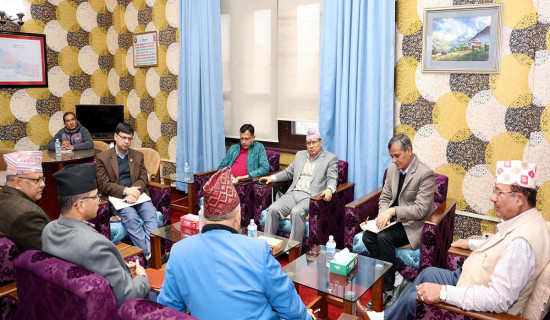- Sunday, 18 January 2026
Urgency Of Transformative Justice In Nepal
Transitional justice faces a fundamental existential challenge due to its uncertain nature and lack of clear indication of its distinctiveness, making it difficult to describe as a “theory of change.” A lack of critical assessment of a wide range of claims and intentions, from formal prosecutions to post-conflict development needs, has been a major cause and consequence. Transitional justice in Nepal has become overloaded and under-conceptualised, with delayed legislation for proper implementation. Meanwhile, finally now, after eighteen years of restoration of peace followed by a decade-long armed conflict, the chapter of the peace process is nearing its conclusion without ensuring a judicial process for victims.
Transitional justice, a paradigm that has faced criticism for its core components, has evolved into queries. Nepal’s move to grant amnesties for human rights violations and international law violations during conflict has been criticized. Nevertheless, while these criticisms are valid, they frequently lack a comprehensive analysis or a proposal of viable alternatives. This is where transformative justice emerges as a critical alternative, offering a more holistic approach that addresses not only the legal and political dimensions of justice but also the deeper issues of social transformation and economic equality that are essential for true post-conflict development and emancipatory justice.
Reparations
Not only does transformative justice exclude any direct mention of the state, but it also excludes the past from its purview, particularly reparations for the past. Traditionally, transitional justice has been seen as a series of actions focused on the past and completed within a specific time frame (“the transition”) in an effort to prevent similar infractions from happening in the future (“never again”). Therefore, the past and a specific method of rendering the past accessible as a repository of human rights violations set the stage for any future direction, such as addressing impunity or averting recurrence.
The agenda for transformative justice requires two revisions to transitional justice: first, it must be reinterpreted as a longer-term process of change (the time of transitional justice) rather than a time-bound one; second, it must clearly articulate the connections between the past, present, and future, emphasising the future (the time within transitional justice).
Transitional justice requires understanding the relationship between continuity and change, the past and present, and the past and present. Government objectives shift from past fixation to future rebuilding, necessitating a temporal reorientation. Recognising structural parallels between past and present violence is crucial. Transitional justice must have strong foundations to serve as “a bridge” between the past and present.
The conception of transitional justice and the passage of time within it is where transformative justice diverges from transitional justice. It is not amenable to containment by a prearranged sequence of actions or window of time in the future is not amenable to containment. Events from the near or distant past, often over and not over at the same time, initiate it.
Transformative justice wants a more ambitious approach to transitional justice, putting process and plurality ahead of single paradigms and predetermined results. It needs ways to deal with new problems and come up with new strategies. As a more comprehensive approach, transformative justice can assist in illuminating the areas where transitional justice is blind, such as “seeing the exclusions” and the meta-structures that support violence and breaches related to human rights. Additionally, victims understand their world and challenges through a “joined-up worldview.” This is only consistent with transformative justice.
Transitional justice efforts for reparations are crucial for mobilisation and capacity building. Participatory democracy, where victims have access to decision-making and public services, is an open-ended process of collective social reparations. Transformative justice mechanisms address the violent past, recognise the interconnectedness of past and present, and challenge unequal power dynamics through strategic action.
The emphasis on transformative practices for victims of injustice challenges legal and normative standards by taking into account the subjectivities of impacted individuals and communities. Victimhood is traumatic, resulting from violent crimes or structural violence due to poverty and inequality. A victim-centred strategy must consider emotions and challenge rights-based approaches to violence’s legacies, allowing remedies to arise directly from victims’ experiences, challenging legalism, and promoting more effective solutions.
Emancipatory justice
Empathy, which is understandable without the need for theory, knowledge, or authority, largely drives the trend of democratising justice. Victims’ stories and testimonies provide a path towards justice, freeing concepts from power dynamics that motivated violations. This approach, rooted in a specific social practice, offers a path towards emancipatory justice, allowing for a more inclusive and equitable approach to justice.
This transformational approach focuses on transnational emotive restitutional remedies to injustice, rooted in the subjectivities of victims. It goes beyond state interaction and mediates the affective labour of the restitutional assemblage, promoting social change beyond the vision of transitional justice through televised trials or truth commissions. This method of scaling and linking goes beyond state interaction and can lead to significant and widespread social change.
As Nepal concludes its peace process, the need for transformative justice becomes increasingly evident. This approach ensures that the judicial process is not only about addressing the past but also about building a better future for all its citizens. Rooted in the experiences and needs of victims and communities, it offers the best hope for lasting peace and social justice in Nepal, ensuring a more equitable and just society.
(The author is a research scholar at the University of Delhi.)
















